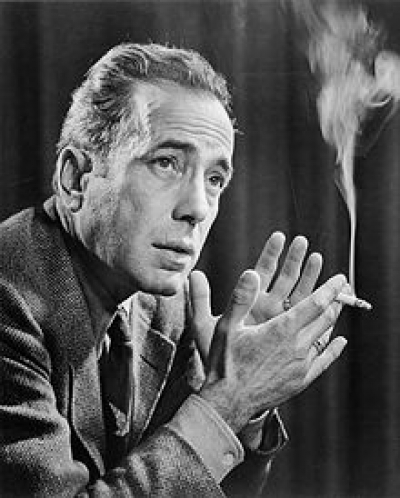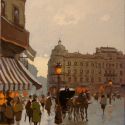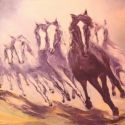
photo: https://karsh.org/photographs/humphrey-bogart/
Biography
Bogart typically played smart, playful, courageous, tough, occasionally reckless characters, living in a corrupt world, yet anchored by an inner moral code. He was also able to play characters with flaws and weaknesses that led to their destruction. His most notable films include We're No Angels (1955) Angels With Dirty Faces (1938), The Maltese Falcon (1941), Casablanca (1942), To Have and Have Not (1944), The Big Sleep (1946), The Treasure of the Sierra Madre (1948), Key Largo (1948), In a Lonely Place (1950), The African Queen (1951) (for which he won an Academy Award for Best Actor in a Leading Role), and The Caine Mutiny (1954). In all, he appeared in 75 feature motion pictures.
Even outside of America, Bogart is seen as a cult figure. French actors such as Jean-Paul Belmondo were deeply influenced by his work and image. In À bout de souffle (known in English as Breathless), perhaps the best-known work of French director Jean-Luc Godard, the protagonist Michel worships the persona of Humphrey Bogart and mimes some of Bogart’s best-known gestures in a way that is both absurd and touching. François Truffaut, another French director of the “New Wave,” directed Shoot the Piano Player, another homage to Bogart. India’s great national movie star Ashok Kumar listed Bogart as a major influence on his “natural” acting style. When Bogart reached Leopoldville to film the movie The African Queen, his plane was met by the U.S. consul and the Congolese press.
Bogart is no less an icon in the country of his birth. One of Woody Allen’s most popular comic movies, Play It Again, Sam, is about a young man in love with Bogart’s aura and intimidated by it. The title refers to a frequent misquote from Casablanca; Ilsa (Ingrid Bergman's character) actually says “Play it, Sam.” In 1997, the United States Postal Service featured Bogart in its “Legends of Hollywood” series. And Entertainment Weekly magazine has named Bogart the number one movie legend of all time.
Bogart’s exalted standing in the Hollywood pantheon would have astonished most of the agents, casting directors and studio bosses who knew him in the 1920s and 1930s as a good but hardly great Broadway stage actor and B-movie player in Hollywood.
Birth and early life
He was born Humphrey DeForest Bogart in New York City, the oldest child of Belmont DeForest Bogart and Maud Humphrey; he had English, Dutch descent, and some Spanish ancestry. His father was a Republican and a Presbyterian, while his mother was a Tory and an Episcopalian; Bogart was raised in his mother's Episcopal church.[1]
It was long believed that his birthday on Christmas Day was a Warner Bros. fiction created to romanticise his background, and that he was really born on January 23, 1899, a date that appears in many references. However, this story is now considered baseless: although no birth certificate has ever been found, his birth notice did appear in a Boston newspaper in early January 1900, which supports the December 1899 date. In addition, the 1900 census for the household of Belmont Bogart lists his son Humphrey as having a birthdate in December of 1899. Lauren Bacall always maintained this was his true birth date.
Childhood
Bogart's father was a successful surgeon. His mother, Maud Humphrey, was a very successful commercial illustrator. Indeed, she used a drawing of baby Humphrey in a well-known ad campaign for Mellins Baby Food. In her prime, she made over $50,000 a year as an illustrator, then a vast sum. The Bogarts lived in a fashionable Upper West Side apartment, and had a cottage in upstate New York.
Maud Humphrey was a distant woman and the Bogarts' marriage was troubled. Both parents were alcoholics and/or morphine addicts at various times. Maud also suffered intense migraine headaches. "I can't say I ever loved my mother," Bogart once said. "I admired her." He was raised mostly by an Irish nurse. "My parents fought," he said another time. "We kids would pull the covers over our ears to keep out the sound of fighting. Our home was kept together for the sake of the children as well as for the sake of propriety."
From his father, Bogart inherited a tendency for needling people, and a love of fishing and especially sailing. Humphrey was the oldest child of three. Both of Bogart's younger sisters were troubled adults; Kay ("Catty") died at 34 of peritonitis complicated by alcoholism. Frances "Pat" Bogart Rose was tall, shy and sweet, but mentally unstable. Bogart was gentle with her and paid for her care. Other relatives were few and rarely saw the Bogarts. (When Bogart fell in love with Lauren Bacall and she introduced him to her large extended family, he said "Christ, you've got more goddamn relatives than I've ever seen.")
As a boy, Bogart was teased for his curls, his tidiness, for the "cute" pictures his mother posed him for, the Little Lord Fauntleroy clothes she dressed him in—and for the name "Humphrey." He was also teased for his lisp; although it has been claimed that he obtained this in the navy when a prisoner hit him in the face with handcuffs, in fact it derived from a childhood accident, in which Bogart got a splinter of wood embedded in his lower lip. "Goddamn doctor," Bogart later told David Niven, "instead of stitching it up, he screwed it up."
School
The Bogarts sent their son to the Trinity School in New York and then to the prestigious prep school Phillips Academy, in Andover, Massachusetts. They hoped he would go on to Yale, but in 1918, Bogart was expelled from Phillips Academy. [1]The details of his expulsion are disputed. One story says that he was expelled for throwing the headmaster into Rabbit Pond, a man-made lake located behind the Andover Inn, while others say that he was expelled for smoking and drinking. His study habits were erratic and his grades low, and he may have hastened his departure by some intemperate comments to those in authority. He had a lifelong dislike of authority figures.
Early career
Bogart did menial labor, joined the Naval Reserve, and eventually drifted into acting. He liked the late hours that actors kept, and enjoyed the attention that an actor got on stage. Most of all, he enjoyed the challenge of putting on a difficult scene, making the audience believe it. He dug deeply into the characters he portrayed, and found them a welcome escape from his own self.
Early theatre work
Bogart began his acting career on the Brooklyn stage in 1921, playing a Japanese butler. He never took acting lessons, and had no formal training. An early reviewer wrote of Bogart's work: "To be as kind as possible, we will only say that this actor was inadequate." Bogart loathed the trivial roles he had to play early in his career, calling them "White Pants Willie" roles.
Bogart appeared in 21 Broadway productions between 1922 and 1935. He played callow juveniles, or the romantic second lead in drawing room comedies. The legend persists that he was the first actor to say "Tennis, anyone?" on stage.
Early in his career, Bogart met his first wife, Helen Menken. They married in 1926, divorced in 1927, and remained friends. In 1928, he married his second wife, Mary Philips. Philips, like Menken, had a fiery temper, once biting the finger of a cop who tried to arrest her for drunkenness.
Spencer Tracy was a serious Broadway actor whom Bogart liked and admired, and they became good friends. It was Spencer Tracy, in 1930, who first called Bogart "Bogie." The name stuck.
The Petrified Forest
In 1934, Bogart starred in the play Invitation to a Murder. The producer Arthur Hopkins saw the play and sent for Bogart when he chose to produce Robert E. Sherwood's new play, The Petrified Forest. Bogart arrived in Hopkins' office while Sherwood was there; Hopkins told him: "I've got a good role for you. A gangster role." Robert Sherwood was sure Hopkins was wrong; Bogart should play the football player. Bogart said later: "They argued back and forth, and I thought Sherwood was right. I couldn't picture myself playing a gangster. So what happened? I made a hit as the gangster."
The Petrified Forest had 197 performances in New York; Bogart played escaped killer Duke Mantee. Leslie Howard, who played the lead, knew how crucial Bogart was to the success of the play. He and Bogart became friends, and he promised to help Bogart reprise his role if Hollywood made the play into a movie.
Bogart was proud of his success as an actor, but the fact that it came from playing a gangster weighed on him. He once said, "I can't get in a mild discussion without turning it into an argument. There must be something in my tone of voice, or this arrogant face—something that antagonizes everybody. Nobody likes me on sight. I suppose that's why I'm cast as the heavy."
Warner Bros. bought the screen rights to The Petrified Forest, signed up Leslie Howard, then tested several Hollywood veterans for the Duke Mantee role, and chose Edward G. Robinson. Bogart cabled news of this to Howard, who was in Scotland. Leslie Howard insisted that Bogart play Duke Mantee. When Warner Bros. saw that Leslie Howard would not budge, they hired Bogart to play Mantee. Bogart never forgot this, and named his only daughter Leslie.
Early film career
Robert E. Sherwood remained a close friend of Bogart's. In 1936, the movie version of The Petrified Forest came out. Bogart got excellent reviews. Still, he was now stuck in a series of crime dramas for Warner Bros. and cast as a heavy, with little acting range. All told, in his career as a tough guy, Bogart went to the electric chair 12 times, and got over 800 years of hard labor. Jack Warner saw nothing wrong with that; as long as the movies made money, and the actors got paid, he saw no reason for anyone to complain.
Mary Philips refused to give up her Broadway career to come to Hollywood with Bogart, and soon they were divorced.
On August 21, 1938, Bogart made a disastrous third marriage, which only heightened his frustration. His third wife was Mayo Methot, a lively, friendly woman when sober, but a paranoid drunk. She was convinced that her husband was cheating on her. The more she and Bogart drifted apart, the more she drank and the more she got furious and threw things at him: plants, crockery, anything close at hand. Bogart sometimes returned fire, and the press dubbed them "the Battling Bogarts." "The Bogart-Methot marriage was the sequel to the Civil War," said their friend Julius Epstein. Another wag observed that there was madness in his Methot. During his marriage to Mayo Methot, Bogart bought a sailboat, which he lightheartedly named Sluggy after his hot-tempered wife.
In 1938, Warner Bros. made Bogart do a "hillbilly musical" called Swing Your Lady, playing a wrestling promoter managing the career of an idiotic giant. In 1939, Bogart reached a new low when he had to play a mad scientist in The Return of Doctor X. Bogart cracked: "If it'd been Jack Warner's blood…I wouldn't have minded so much. The trouble was they were drinking mine and I was making this stinking movie."
The studio system, then in its heyday, largely restricted actors to one studio, and Warner Bros. had no interest in making Bogart a star. The system was made for quantity, not quality. Shooting on a new movie might begin days or only hours after shooting on the last movie was complete. Any actor who refused a role could be suspended without pay. Bogart didn't like the roles chosen for him, but he worked steadily: between 1936 and 1940, Bogart averaged a new movie every two months. He thought that Warner Bros. were cheap in their wardrobe department, and often wore his own personal suits in his movies. On the movie High Sierra, Bogart used his own mutt to play his character's dog "Pard."
The leading men ahead of Bogart included not just such classic stars as James Cagney, Spencer Tracy and Edward G. Robinson—but also actors far less well-known today, such as Victor McLaglen, George Raft and Paul Muni. Most of the better movie scripts Warner Bros. bought went to these men. Bogart had to take what was left. He made movies with names like Racket Busters, San Quentin, and You Can't Get Away With Murder. The only substantial roles he ever got during this period were in Samuel Goldwyn's Dead End (1937) and Angels with Dirty Faces (1938) (another picture in which he gets shot by James Cagney). Bogart rarely saw his own movies and didn't even attend the premieres, which were an expected part of the actor's job.
Bogart had been raised to believe that acting was something beneath a gentleman. Acting in movies was even worse than on the stage, and playing depraved gunmen in "B" pictures for Warner Bros. was not something to be mentioned in polite company.
In California, in the 1930s, Bogart bought a 55-foot sailing yacht from Dick Powell. The sea was his sanctuary. He was a serious sailor, respected by other sailors who had seen too many Hollywood actors and their boats. About 30 weekends a year, he went out on his boat. He once said: "An actor needs something to stabilize his personality, something to nail down what he really is, not what he is currently pretending to be."
He had a lifelong disgust for the pretentious, fake or phony. Sensitive yet caustic, and disgusted by the inferior movies he was churning out, Bogart cultivated the persona of a soured idealist, a man exiled from better things in New York, living by his wits, drinking too much, cursed to live out his life among second-rate people and projects. When he thought an actor, director or a movie studio had done something shoddy, he spoke up about it, and was willing to be quoted on the record. The Hollywood press, unaccustomed to candor, was delighted. Bogart once said, "All over Hollywood, they are continually advising me 'Oh, you mustn't say that. That will get you in a lot of trouble' when I remark that some picture or writer or director or producer is no good. I don't get it. If he isn't any good, why can't you say so? If more people would mention it, pretty soon it might start having some effect."
Rise to stardom
High Sierra
High Sierra, a 1941 Raoul Walsh movie, was written by Bogart's friend and drinking partner, John Huston. The movie was a step forward for Bogart. He still played the villain, "Mad Dog" Roy Earle. He still died at the end; but at least he got to kiss Ida Lupino, and to play a character with some depth. In a climactic scene, Bogart's character slid 90 feet down a mountainside to his punishment. His stunt double, Buster Wiles, bounced a few times going down the mountain and wanted another take to do better. "Forget it," said Raoul Walsh. "It's good enough for the 25-cent customers."
Bogart and Huston enjoyed each other, and drew on each other's gifts. Bogart had always been self-conscious about being a small man (5'8" tall); Huston was six-two (and his rail-thin build made him appear to be even taller). Bogart had never been close to his father; Huston was very close to his father, the actor Walter Huston.
Bogart admired and somewhat envied Huston because Huston got to write scripts, to shape a story and make sure it had heft. Though a poor student, Bogart was a lifelong reader. He could quote Plato, Pope, Ralph Waldo Emerson and over a thousand lines of Shakespeare. He admired writers, and some of his best friends were screenwriters, including Louis Bromfield, Nathaniel Benchley and Nunnally Johnson.
John Huston reported being easily bored, and admired Bogart not just for his acting talent but for his intense concentration. It was Huston who would later give Bogart one of his best roles - the psychotic Fred C. Dobbs in the 1948 classic, The Treasure of the Sierra Madre.
The Maltese Falcon
James Cagney and George Raft had both turned down Bogart's part in High Sierra; Raft didn't want to play a character who died at the end. Then George Raft turned down the male lead in John Huston's directorial debut, The Maltese Falcon, also 1941.
Bogart grabbed the part and audiences saw him play a leading role with real complexity. His character, Sam Spade, was still capable of duplicity and violence, but he was a leading man: handsome, smart, fated to survive. When he discovered his sexy client was a murderess, he turned her in, with a speech he made famous: "I don't care who loves who. I won't play the sap for you! You killed Miles and you're going over for it. I hope they don't hang you by your sweet neck. If you're a good girl, you'll be out in 20 years and you'll come back to me. If they hang you, I'll always remember you."
As America entered World War II, it was turning to a new kind of leading man, less dapper and polished, but tougher and more willing to use violence to make the world safe and to get what he wanted. Bogart's persona was much better suited to the war years than to the 1930s. Bogart played a guy who'd grown up on the streets, a guy who knew how to fire a gun, how to punch a guy on the jaw, and spit out "Tell that to your boss."
In Casablanca, "Everybody comes to Rick's."
Casablanca
Bogart got his first real romantic lead in Casablanca, playing Rick Blaine, the nightclub owner. Bogart had learned how to convey pain in his eyes and to show emotion with subtle shadings of his voice. He was still young but looked like a man who had lived hard.
As Casablanca became an iconic movie, much was made of the fact that its script was still being written as shooting on the movie began. Less well understood is that the character of Rick Blaine drew powerfully on the persona that Bogart had been cultivating in real life for at least six years. The soured idealist; the loner; the hard-drinking man exiled from better things in New York—all of these were crucial parts of Rick Blaine—and of Bogart. Bogart played a complex man wary of showing his emotions or ideals, a chess player who kept even his friends off balance. In real life, Bogart himself played tournament chess, achieving expert strength, one level below master level. Bogart reportedly asked that Blaine also be portrayed as a chess player.
Bogart was surrounded by a fine international cast, including Ingrid Bergman, Claude Rains, Peter Lorre, Sydney Greenstreet, Paul Henreid and Conrad Veidt. Dooley Wilson played the part of Sam, Rick's confidant and piano player, even though he could not play the piano. The script and Max Steiner's musical score have both been praised extensively, as has the cinematography.
The stories that Ronald Reagan had been offered, but passed on, the role of Rick are just that, stories, resulting from the casual lies pumped out by studio publicity departments in those days to keep fans interested in the activities of a star who was not doing anything newsworthy at the time. Warner Bros.' publicity department concocted similar tales during the shooting of Casablanca, e.g., that Bogart was learning Swedish so that he could woo Bergman, that were just as spurious.
Off the set, Bergman and Bogart hardly spoke during the filming of Casablanca. She said later, "I kissed him but I never knew him." Years later, after Ingrid Bergman had taken up with Italian director Roberto Rossellini, and borne him a child, Bogart bawled her out for it. "You used to be a great star," he said. "What are you now?" "A happy woman," she replied.
Casablanca won the 1943 Academy Award for Best Picture. Bogart was nominated for the Best Actor in a Leading Role, but lost out to Paul Lukas for his performance in Watch on the Rhine.
Bogart and Bacall
Only Bogart's fourth marriage, to Lauren Bacall ("Baby"), was a happy one. They met while filming To Have and Have Not, in which Bogart played a tough, independent fisherman named Steve, who gets pushed to his limit by some unsavory people and then gets his revenge. They were married on May 21, 1945 in Mansfield, Ohio, at Malabar Farm, the country home of Pulitzer Prize-winning author Louis Bromfield, who was a close friend of Bogart's.
Bacall became an overnight sensation with a famous line delivered to Bogart. Leaning against a doorway, her head down and voice low, she told Bogart's character: "You know how to whistle, don't you, Steve? Just put your lips together, and blow."
Bogart fell in love with Bacall. The movie's director, Howard Hawks, once commented: "When two people are falling in love with each other, they're not tough to get along with, I can tell you that. Bogie was marvelous. I said "You've got to help" and of course after a few days he really began to get interested in the girl. That made him help more." Hawks also said of Bacall: "She had to keep practicing for six to eight months to keep that low voice. Now, it's perfectly natural. And the funny thing is that Bogie fell in love with the character she played, so she had to keep playing it the rest of her life."
Bogart had another strong, unspoken friendship with Walter Brennan, who played the harmless drunk Eddie in To Have and Have Not. Hawks recalled: "The fellow who rented their boat said 'What do you take care of him for?' Bogart looked at him and said, 'He thinks he's taking care of me.' And he wasn't very nice the way he said it. Those are the relationships that happen between men."
Bogart and Bacall in The Big Sleep (1946)
Bogart and Bacall's relationship is at the heart of the film noir masterpiece The Big Sleep. The plot is complex and has holes in it that even Raymond Chandler, who wrote the novel on which it was based, could not explain. Hawks himself admitted "I never figured out what was going on but I thought [it] had great scenes in it…After that got by, I said, 'I'm never going to worry about being logical again.'"
Chandler thoroughly admired Bogart's performance: "Bogart can be tough without a gun. Also he has a sense of humor that contains that grating undertone of contempt."
Bacall allowed Bogart lots of weekend time on his boat. She got seasick on boats and Bogart liked the boat to be an all-male preserve, stating "The trouble with having dames on board is you can't pee over the side." Bogart would frequently sail to Catalina with friends or set some lobster traps.
Bogart allowed Bacall romantic crushes on Adlai Stevenson and Leonard Bernstein, knowing she'd married young before ever having much chance to date. But he made it clear he'd leave Bacall if she ever had an affair. She never did. Bacall once wrote of Bogart: "You had to stay awake married to him. Every time I thought I could relax and do everything I wanted, he'd buck. There was no way to predict his reactions, no matter how well I knew him."
Bogart and Bacall moved into a $160,000 white brick mansion in Holmby Hills, an exclusive neighborhood between Beverly Hills and Bel-Air. Bogart and Bacall had two Jaguar cars, and three blooded Boxer dogs. Bogart said "We moved where all the creeps live." But he enjoyed some of his neighbors, especially Judy Garland.
When Lauren Bacall learned she was pregnant, she was ecstatic. Bogart came home from a day at the studio, and she met him with the great news. He grew very quiet. He put his arm around her and led her gently into the house. He was quiet during dinner—and then, after dinner, Bogart and Bacall had the worst fight they ever had. Bogart had finally found a woman he truly loved, and he didn't want to share her. He was scared of losing her affection to a baby.
When Lauren Bacall gave birth to a son, Stephen, Bogart became a father at 49. He'd had months to absorb the news, had even had his own baby shower. (Frank Sinatra had brought him baby rattles.) But Bogart still felt awkward about being a father. ("What do you do with a kid?" he asked a friend. "They don't drink.") In 1952, they had their second child, Leslie (a girl, named after actor Leslie Howard).
Bogart parties
There are many tales from the 1950s about Bogart's behaviour in bars and clubs.
The panda case
In 1950, Bogart and his friend Bill Seeman arrived at the El Morocco Club in New York after midnight. Bogart had bought two giant stuffed panda bears for Stephen, and he and Seeman introduced the bears around as their "dates" and demanded a table for four. They propped up the bears in separate chairs, and began doing some heavy drinking.
Two young women at the club saw the pandas. One of them picked up one of the pandas. Bogart got angry and pushed her. After she fell to the floor, her friend picked up the other panda, Bogart said something cruel, and her boyfriend arrived and began throwing plates. After a wild scuffle, Bogart, Seeman and the pandas were thrown out of El Morocco and told never to return.
One of the women sued Bogart for $25,000. He showed up in court and was asked: "Were you drunk?" "Isn't everybody at three in the morning?" he replied. The case was dropped. Later, he mused: "Errol Flynn and I are the only ones left who do any good old hell-raising."
Stories from Romanoff's
Bogart loved to go to Romanoff's in Beverly Hills. A valet would take the Jaguar, and a maitre d' would lead Bogart to his regular booth. Friends would stop by to chat or talk shop: David Niven, Judy Garland, Richard Brooks, Marilyn Monroe, Swifty Lazar, Spencer Tracy. Rock Hudson was a rising star; when he saw him, Bogart would ask, "What the hell kind of name is 'Rock' Hudson?"
Bogart considered Mike Romanoff a poseur but nonetheless counted him a close friend. Among other things, Bogart admired him as a chess player and appreciated his tendency to needle people. Mike Romanoff was a man with a cultivated Oxford accent, who insisted that his true name was "Prince Michael Alexandrovitch Dmitri Obolensky Romanoff", and that he was a blood nephew of the former Russian tsar.
Romanoff would greet Bogart by saying, "Good afternoon, Mr. Bogart. Are you going to be paying your bill today? I thought that might be a pleasant change." Bogart would smile and reply: "Are you going to be putting any alcohol in your drinks today? That might be a pleasant change." If Bacall was with Bogart, Romanoff might turn to her and say: "I see that you are still dating the same aging actor."
Later career
The African Queen
Humphrey Bogart on a United States stamp
In 1951, Bogart starred in the movie The African Queen, with Katharine Hepburn, again directed by his friend John Huston. It was a difficult shoot, on location in Africa; one day, the eponymous boat even sank (Lauren Bacall recalled: "The natives had been told to watch it and they did—they watched it sink").
John Huston recalled:
"Bogie didn't particularly care for the Charlie Alnutt role when he started, but I slowly got him into it, showing him by expression and gesture what I thought Alnutt should be like. He first imitated me, then all at once he got under the skin of that wretched, sleazy, absurd, brave little man. He realized he was on to something new and good. He said to me, 'John, don't let me lose it.'"
Hepburn's proper spinster character scolded Bogart's Charlie Alnutt: "Nature, Mr. Alnutt, is what we are put in this world to rise above." Bogart had a famous put down too: "You crazy, psalm-singing, skinny old maid!"
The role of Charlie Alnutt won Bogart his first Academy Award for Best Actor in a Leading Role in 1952. He had vowed to friends that if he won, his speech would break the convention of thanking everyone in sight. He would say instead: "I don't owe anything to anyone! I earned this award by hard work and paying attention to my craft." But when Bogart won the Academy Award, he thanked John Huston, Katharine Hepburn, the cast and crew of the movie. He had always felt Hollywood people did not like him much, and he was deeply moved to find himself so popular now.
Final roles
Also in 1951, Bogart and Bacall co-starred in the syndicated radio drama Bold Venture, for which he was paid a reported $4000 a week. He played a character very much like Steve in To Have and Have Not, and she played his "ward". He called her "Sailor".
Bogart relied on his standing with his fellow actors to organize a delegation who went to Washington, D.C., during the height of McCarthyism, to protest the House Unamerican Activities Committee's harassment of Hollywood writers and actors. Bogart was not, however, prepared to deal with the industry pressure to abandon this campaign; within a year he disavowed his activities, retreating to his role as actor and apologizing for speaking out on politics.
The Caine Mutiny was Bogart's last major movie. He dropped his asking price to get the role of Captain Queeg, then griped with some of his old bitterness about it. ("This never happens to Cooper or Grant or Gable, but always to me. Why does it happen to me?")
Bogart gave a bravura performance as Captain Queeg. Queeg was in many ways an extension of the character he had played in The Maltese Falcon, Casablanca, and The Big Sleep—the wary loner who trusts no one—but with none of the warmth or humor that made those characters so appealing. Like his portrayal of Fred C. Dobbs in The Treasure of the Sierra Madre, Bogart played—but did not overplay—a paranoid, self-pitying character whose small-mindedness eventually destroyed him.
Bogart appeared in The Left Hand of God (1955) shortly before his death.
In 1955, he made three movies: The Desperate Hours, The Left Hand of God, and We're No Angels. Each movie had a special satisfaction. The Desperate Hours gave him a third chance to play a hostage drama. During The Left Hand of God, Bogart was able to befriend Gene Tierney, and encourage her to get the psychiatric help he thought she badly needed. In We're No Angels, he got a starring role for Joan Bennett, who'd been out of work for three years after a family scandal.
Death
By the late 1950s, Bogart's health was failing. He had always treated his body poorly, and often drank heavily when not working. (Typically contrary, the one night he refused to get drunk was New Year's Eve.) He smoked unfiltered Chesterfields. Once, after signing a long-term deal with Warner Bros., Bogart predicted with glee that his teeth and hair would fall out before the contract ended. That sent a fuming Jack Warner to his lawyers.
Bogart eventually contracted cancer of the esophagus. He almost never spoke of it and refused to see a doctor until January of 1956, and by then removal of his esophagus, two lymph nodes and a rib was too little, too late.
Katharine Hepburn and Spencer Tracy came to see him. Bogart was too weak to walk up and down stairs. He tried to joke about it: "Put me in the dumbwaiter and I'll ride down to the first floor in style. Come on—I'm a little guy—I'll fit."
Hepburn has described the last time she and Spencer Tracy saw Bogart: "Spence patted him on the shoulder and said, 'Goodnight, Bogie.' Bogie turned his eyes to Spence very quietly and with a sweet smile covered Spence's hand with his own and said, 'Goodbye, Spence.' Spence's heart stood still. He understood."
Bogart had just turned 57 and weighed only 80 pounds (36 kg) when he died on January 14, 1957 after falling into a coma. He died in Hollywood. His funeral was held at All Saints Episcopal Church with musical selections played from Bogart's favorite composers, Johann Sebastian Bach and Claude Debussy. Bacall had asked Spencer Tracy to give the eulogy but Tracy was too upset. John Huston gave the eulogy instead, and reminded the gathered mourners that while Bogart's life had ended far too soon, it had been a rich one. Huston said: "He is quite irreplaceable. There will never be another like him."
Huston also noted of Bogart:
"Himself, he never took too seriously—his work most seriously. He regarded the somewhat gaudy figure of Bogart, the star, with an amused cynicism; Bogart, the actor, he held in deep respect…In each of the fountains at Versailles there is a pike which keeps all the carp active; otherwise they would grow overfat and die. Bogie took rare delight in performing a similar duty in the fountains of Hollywood. Yet his victims seldom bore him any malice, and when they did, not for long. His shafts were fashioned only to stick into the outer layer of complacency, and not to penetrate through to the regions of the spirit where real injuries are done."
Katharine Hepburn said:
"He was one of the biggest guys I ever met. He walked straight down the center of the road. No maybes. Yes or no. He liked to drink. He drank. He liked to sail a boat. He sailed a boat. He was an actor. He was happy and proud to be an actor. He'd say to me, 'Are you comfortable? Everything okay?' He was looking out for me."
His cremated remains are interred in Forest Lawn Memorial Park Cemetery, Glendale, California. Buried with him is a small gold whistle, which he had given to his future wife, Lauren Bacall, before they married. In reference to their first movie together, it was inscribed: "If you want anything, just whistle."
Humphrey Bogart's hand and foot prints are immortalized in the forecourt of Grauman's Chinese Theater and he has a star on the Hollywood Walk of Fame at 6322 Hollywood Boulevard in Hollywood.
After his death, the "Bogie Cult" formed at the Brattle Theatre which contributed to his spike in popularity in the late 50's and 60's.
Quotes
Attributed
Wikiquote has a collection of quotations related to:
"I can't say I ever loved my mother, I admired her."
"My parents fought. We kids would pull the covers over our ears to keep out the sound of fighting. Our home was kept together for the sake of the children as well as for the sake of propriety."
"I don't approve of the John Waynes and the Gary Coopers saying 'Shucks, I ain't no actor—I'm just a bridge builder or a gas station attendant.' If they aren't actors, what the hell are they getting paid for? I have respect for my profession. I worked hard at it."
His last words were, "I never should have switched from scotch to martinis."
Famous movie quotes
Casablanca
"I stick my neck out for nobody."
"There are certain sections of New York, Major, that I wouldn't advise you to try to invade." [to Major Strasser]
"Of all the gin joints in all the towns in all the world, she walks into mine."
"You played it for her, you can play it for me! . . . If she can stand it, I can! Play it!"
"Here's looking at you, kid."
"Tell me, who was it you left me for? Was it Laszlo, or were there others in between? Or — aren't you the kind that tells?"
"Don't you sometimes wonder if it's worth all this? I mean what you're fighting for."
"If that plane leaves the ground and you're not with him, you'll regret it. Maybe not today, maybe not tomorrow, but soon — and for the rest of your life."
"I'm no good at being noble, but it doesn't take much to see that the problems of three little people don't amount to a hill of beans in this crazy world. Someday you'll understand that."
"Louis, I think this is the beginning of a beautiful friendship."
"We'll always have Paris."
Films
For a list of all Bogart's films see Humphrey Bogart filmography.
See also
Bogart-Bacall Syndrome
References
↑ David Wallechinsky & Amy Wallace: The New Book of Lists, p.9. Canongate, 2005. ISBN 1841957194.
Halliwell's Film, Video and DVD Guide (2004), Lesley Halliwell, HarperCollins Entertainment, ISBN 0007190816
"Time Out" Film Guide (2004), John Pym (ed), Time Out Group Ltd, ISBN 1904978215
Further reading
The Secret Life of Humphrey Bogart: The Early Years (1899-1931) (2003), Darwin Porter, Georgia Literary Association, ISBN 0966803051
Bogart: A Life in Hollywood (1997), Jeffrey Meyers, Andre Deutsch Ltd, ISBN 0233991441

































